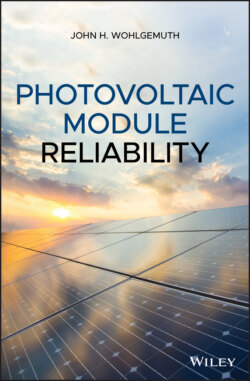Читать книгу Photovoltaic Module Reliability - John H. Wohlgemuth - Страница 14
1.4 What Does Reliability Mean for PV Modules?
ОглавлениеSince the book is entitled “Reliability of Photovoltaic Modules,” it is important to explain what reliability means in this context. In the simplest sense, reliability of a product means that it performs the promised functions for the expected lifetime. For a PV module, the promised function is continued production of the specified amount of electricity in a safe manner. Typically, the product warranty will specify both the amount of power retained (something like retention of 80% of initial power) and the time period over which it should retain this power level (often 25 years). So, if a particular module fails to produce this amount of power or if it becomes unsafe (maybe it has too high a leakage current or it falls out of the frame), then it is considered a failure. For a particular type of module, the term reliable would indicate that a certain percentage (maybe something like >95%) are still operating within the specified power limit throughout the length of the warranty period.
Another word often used to describe PV modules is their durability. The dictionary defines durability as “the ability to withstand wear, pressure, or damage.” PV modules must be durable since they are exposed to the stresses of the outdoor environment when deployed. For modules, durability has come to mean the continued ability to provide output power over its lifetime. Rather than focusing on failure as reliability does, durability focuses on maintaining the output power level. As a module ages, it may slowly degrade in output power. This is usually reported as an annual degradation rate although the rate is often not linear, but that is the way it is reported for simplicity. So, what does it really mean if one particular module type deployed at a specific geographic location has a reported annual degradation rate of 1% after having been deployed at the site for five years? This really means that the average module output power has dropped by 5% over the five‐year exposure time. The annual degradation rate is an important factor used in evaluating potential financial payback from the investment in the PV array. Investors want to know what annual degradation rate they can expect from the module type they are purchasing.
The final term to discuss in this section is module lifetime. This is a measure of how long the module will continue to produce power at the specified level in a safe manner. The warranty typically provides an estimated lifetime which should be the minimum time over which the product will continue to operate and meet the warrantied power. Once again, these values are typically 80% output power after 25 years. The real question is how the customer defines the lifetime. When does the owner of the PV modules decide that they have degraded too much and need to be retired and perhaps replaced? Experience indicates that the 80% level may be a reasonable benchmark to use because once modules have degraded below this power level, they often start having other problems like ground faults, breakage, etc. So, while there is certainly no consensus on defining module lifetime, this book will consider the useful life of a module over when the power has decreased to less than 80% of the original specification. For an array of modules, this would typically mean that the power of the array or the average power of the modules has dropped to 80% of the initial specified output power.
